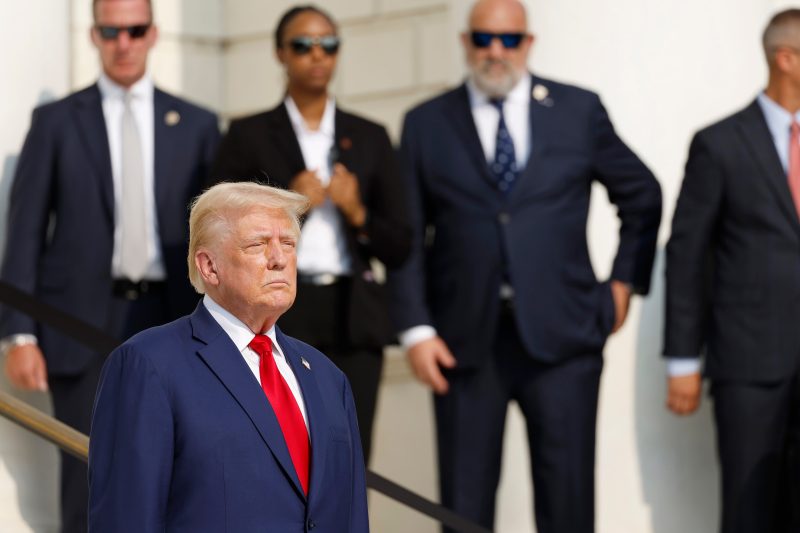
Did Trump’s campaign break the law at Arlington National Cemetery?
The details of the dispute over Donald Trump’s campaign aides shooting photos and video in Section 60 of Arlington National Cemetery matter, as I wrote earlier. If they were told that filming in this hallowed area wasn’t allowed — as a U.S. defense official tells The Washington Post they were, more than once — and bulldozed ahead, that would be at least something of a scandal. Trump’s campaign has suggested there was a dispute but has said “there was no physical altercation as described.”
Even aside from the nature of the clash, which NPR reported got physical, we’re left with a very important question: Was shooting those photos and that video illegal, in and of itself?
Arlington National Cemetery’s statement certainly suggested it was.
“Federal law prohibits political campaign or election-related activities within Army National Military Cemeteries, to include photographers, content creators or any other persons attending for purposes, or in direct support of a partisan political candidate’s campaign,” the cemetery said Tuesday. “Arlington National Cemetery reinforced and widely shared this law and its prohibitions with all participants.”
The apparently applicable law here is 32 CFR § 553.32. That law says the executive director of the Army National Military Cemeteries shall “ensure the sanctity of public and private memorial and ceremonial events.”
“All memorial services and ceremonies within Army National Military Cemeteries, other than official ceremonies, shall be purely memorial in purpose,” it says.
It adds: “Memorial services and ceremonies at Army National Military Cemeteries will not include partisan political activities.”
As for whether Trump’s and his campaign’s actions are “partisan political activities”?
Trump has no official role in the U.S. government right now, and the political purpose of the visit would seem pretty evident. In addition to Trump visiting the cemetery with campaign aides, his team has in recent days sought to highlight the Biden administration’s chaotic 2021 withdrawal from Afghanistan and attach it to Vice President Kamala Harris.
The Trump team has also shared the images in a very campaign-oriented way. Top campaign aide Dan Scavino posted a video of Trump laying a wreath with family members. Some family members spoke at last month’s Republican National Convention.
pic.twitter.com/sc9rGv7sYh
— Dan Scavino Jr. (@DanScavino) August 26, 2024
And Trump’s TikTok post featured clips of his visit and Trump saying, “And then they took over that disaster — the leaving of Afghanistan.” The caption appended: “Should have never happened.”
In other words, this goes beyond merely memorializing the dead; Trump is making an argument about the relative merits of himself and his successors in leading the federal government — one of whom he’s running against.
Micki McElya, a University of Connecticut history professor who wrote a book on Arlington National Cemetery, said politics are inherent at the cemetery, which often has to navigate that: “There is a long tradition of military families and veterans making their grief public to call leaders to account for their policies, actions, and words, and these protests have come from all along the political spectrum.”
But McElya called it “undeniable” that the Trump visit was a campaign event.
Tanya Marsh, an expert on funeral and cemetery law at Wake Forest University, added that U.S. law gives cemeteries broad authority to establish rules, including for visitors.
“Barring a private photographer who appears to be acting on behalf of a political campaign is certainly something that appears to be within the cemetery’s authority,” Marsh said. “So, yes, if the campaign was filming during the wreath-laying ceremony for partisan political activities, that would be a violation of federal law.”
The Trump campaign has shared a snippet of an email that it suggested involved the cemetery giving it clearance. But the snippet didn’t specifically address Section 60. (Photography is generally allowed, for example, at the Tomb of the Unknowns, as the above photo demonstrates.) The Trump campaign hasn’t responded to a request for the full email.
The campaign has also shared text messages indicating that the family members approved of the Trump campaign having media present, a point that Trump running mate Sen. JD Vance (R-Ohio) emphasized Wednesday.
“They invited him to be there and to support them,” Vance said.
But that, again, doesn’t specifically address the crux of the matter.
“While the families’ statement that they invited and approved of the campaign photographer’s presence in Section 60 may soften the remarkable cynicism and crass behavior of the Trump campaign in the eyes of some people,” McElya said, “the law does not give them the authority to sanction campaign photography.”
For now, it’s not known what kind of probing there might be into the matter. The cemetery said it filed a report, but it’s not clear to whom the report was sent. And even if the Trump campaign’s photography was illegal, the law doesn’t specify criminal penalties.
Beyond that, there’s the question of whether charges could be brought related to the altercation that NPR initially reported took place. NPR’s source said campaign staff verbally abused and pushed the cemetery official.
At least one member of Congress — Rep. Gerry Connolly (D), who represents Northern Virginia — is calling for more information from that report and from the cemetery.
